Data Driven Robust Energy and Reserve Dispatch Based on a Nonparametric Dirichlet Process Gaussian Mixture Model
Abstract
1. Introduction
2. Data Driven Polyhedral Uncertainty Set Based on the Dirichlet Process Gaussian Mixture Model
2.1. Nonparametric Dirichlet Process Gaussian Mixture Model
2.2. Data Driven Polyhedral Uncertainty Set
3. Data Driven Robust Energy and Reserve Dispatch Model
4. Simplified Model and Model Solution Methodology
4.1. Simplified Model
4.2. Solution Methodology
5. Computational Experiments
5.1. Performance Evaluation of Proposed Data Driven Polyhedral Uncertainty Set
5.2. Case Study on an PJM-5 Bus System
5.3. Case Study on an IEEE-118 Bus System
6. Conclusions
Author Contributions
Funding
Conflicts of Interest
References
- U.S. Department of Energy. 20% Wind Energy By 2030: Increasing Wind Energy’s Contribution to US Electricity Supply; Diane Publishing: Collingdale, PA, USA, 2008.
- IRENA. REmap 2030: A Renewable Energy Roadmap; International Renewable Energy Agency: Abu Dhabi, UAE, 2014. [Google Scholar]
- International Energy Agency. China Wind Energy Development Roadmap 2050; International Energy Agency: Paris, France, 2011. [Google Scholar]
- Zheng, Q.P.; Wang, J.; Liu, A.L. Stochastic Optimization for Unit Commitment—A Review. IEEE Trans. Power Syst. 2015, 30, 1913–1924. [Google Scholar]
- Lowery, C.; O’Malley, M.J. Reserves in Stochastic Unit Commitment: An Irish System Case Study. IEEE Trans. Sustain. Energy 2015, 6, 1029–1038. [Google Scholar] [CrossRef]
- Bertsimas, D.; Litvinov, E.; Sun, X.A.; Zhao, J.; Zheng, T. Adaptive Robust Optimization for the Security Constrained Unit Commitment Problem. IEEE Trans. Power Syst. 2013, 28, 52–63. [Google Scholar] [CrossRef]
- Delage, E.; Ye, Y. Distributionally Robust Optimization Under Moment Uncertainty with Application to Data-Driven Problems. Oper. Res. 2010, 58, 595–612. [Google Scholar] [CrossRef]
- Chen, Y.; Wei, W.; Liu, F.; Mei, S. Distributionally robust hydro-thermal-wind economic dispatch. Appl. Energy 2016, 173, 511–519. [Google Scholar] [CrossRef]
- Wei, W.; Liu, F.; Mei, S. Distributionally Robust Co-Optimization of Energy and Reserve Dispatch. IEEE Trans. Sustain. Energy 2016, 7, 289–300. [Google Scholar] [CrossRef]
- Wang, Z.; Bian, Q.; Xin, H.; Gan, D. A Distributionally Robust Co-Ordinated Reserve Scheduling Model Considering CVaR-Based Wind Power Reserve Requirements. IEEE Trans. Sustain. Energy 2016, 7, 625–636. [Google Scholar] [CrossRef]
- Duan, C.; Jiang, L.; Fang, W.; Liu, J. Data-driven Affinely Adjustable Distributionally Robust Unit Commitment. IEEE Trans. Power Syst. 2017, 33, 1385–1398. [Google Scholar]
- Yao, L.; Wang, X.; Duan, C.; Guo, J.; Wu, X.; Zhang, Y. Data-driven distributionally robust reserve and energy scheduling over Wasserstein balls. IET Gener. Transm. Distrib. 2018, 12, 178–189. [Google Scholar] [CrossRef]
- Zhao, C.; Guan, Y. Data-Driven Stochastic Unit Commitment for Integrating Wind Generation. IEEE Trans. Power Syst. 2015, 31, 2587–2596. [Google Scholar] [CrossRef]
- Xiong, P.; Singh, C. A Distributional Interpretation of Uncertainty Sets in Unit Commitment under Uncertain Wind Power. IEEE Trans. Sustain. Energy 2018, 10, 149–157. [Google Scholar] [CrossRef]
- Guan, Y.; Wang, J. Uncertainty Sets for Robust Unit Commitment. IEEE Trans. Power Syst. 2014, 29, 1439–1440. [Google Scholar] [CrossRef]
- Ning, C.; You, F. Data-Driven Adaptive Robust Unit Commitment Under Wind Power Uncertainty: A Bayesian Nonparametric Approach. IEEE Trans. Power Syst. 2019, 34, 2409–2418. [Google Scholar] [CrossRef]
- Golestaneh, F.; Pinson, P.; Azizipanah-Abarghooee, R.; Gooi, H.B. Ellipsoidal Prediction Regions for Multivariate Uncertainty Characterization. IEEE Trans. Power Syst. 2018, 33, 4519–4530. [Google Scholar] [CrossRef]
- Golestaneh, F.; Pinson, P.; Gooi, H.B. Polyhedral Predictive Regions for Power System Applications. IEEE Trans. Power Syst. 2018, 34, 693–704. [Google Scholar] [CrossRef]
- Hu, B.; Wu, L. Robust SCUC With Multi-Band Nodal Load Uncertainty Set. IEEE Trans. Power Syst. 2016, 31, 2491–2492. [Google Scholar] [CrossRef]
- Venzke, A.; Halilbasic, L.; Markovic, U.; Hug, G.; Chatzivasileiadis, S. Convex Relaxations of Chance Constrained AC Optimal Power Flow. IEEE Trans. Power Syst. 2018, 33, 2829–2841. [Google Scholar] [CrossRef]
- Ke, D.; Chung, C.Y.; Sun, Y. A Novel Probabilistic Optimal Power Flow Model with Uncertain Wind Power Generation Described by Customized Gaussian Mixture Model. IEEE Trans. Sustain. Energy 2015, 7, 200–212. [Google Scholar] [CrossRef]
- Wang, Z.; Shen, C.; Liu, F.; Wu, X.; Liu, C.C.; Gao, F. Chance-Constrained Economic Dispatch with Non-Gaussian Correlated Wind Power Uncertainty. IEEE Trans. Power Syst. 2017, 32, 4880–4893. [Google Scholar] [CrossRef]
- Blei, D.M.; Jordan, M.I. Variational inference for Dirichlet process mixtures. Bayesian Anal. 2006, 1, 121–143. [Google Scholar] [CrossRef]
- Teh, Y.W.; I Jordan, M.; Beal, M.J.; Blei, D.M. Hierarchical Dirichlet Processes. J. Am. Stat. Assoc. 2006, 101, 1566–1581. [Google Scholar] [CrossRef]
- Bishop, C.M. Pattern Recognition and Machine Learning; Springer: New York, NY, USA, 2006. [Google Scholar]
- Zhu, J.; Ge, Z.; Song, Z. Variational Bayesian Gaussian Mixture Regression for Soft Sensing Key Variables in Non-Gaussian Industrial Processes. IEEE Trans. Control Syst. Technol. 2016, 25, 1092–1099. [Google Scholar] [CrossRef]
- Wu, L. A Tighter Piecewise Linear Approximation of Quadratic Cost Curves for Unit Commitment Problems. IEEE Trans. Power Syst. 2011, 26, 2581–2583. [Google Scholar] [CrossRef]
- Jiang, R.; Wang, J.; Guan, Y. Robust Unit Commitment with Wind Power and Pumped Storage Hydro. IEEE Trans. Power Syst. 2012, 27, 800–810. [Google Scholar] [CrossRef]
- Ye, H.; Li, Z. Robust Security-Constrained Unit Commitment and Dispatch with Recourse Cost Requirement. IEEE Trans. Power Syst. 2016, 31, 3527–3536. [Google Scholar] [CrossRef]
- Ye, H.; Wang, J.; Li, Z. MIP Reformulation for Max-min Problems in Two-stage Robust SCUC. IEEE Trans. Power Syst. 2016, 32, 1237–1247. [Google Scholar] [CrossRef]
- NREL National Renewable Energy Laboratory. Available online: https://www.nrel.gov/wind/data-tools.html (accessed on 24 December 2018).
- Li, Z.; Qiu, F.; Wang, J. Data-driven real-time power dispatch for maximizing variable renewable generation. Appl. Energy 2016, 170, 304–313. [Google Scholar] [CrossRef]
- Wei, W.; Liu, F.; Mei, S.; Yunhe, H. Robust Energy and Reserve Dispatch Under Variable Renewable Generation. IEEE Trans. on Smart Grid 2015, 6, 369–380. [Google Scholar] [CrossRef]
- 118bus_ro. Available online: http://motor.ece.iit.edu/data/118bus_ro.xls (accessed on 25 March 2020).
- Dai, L.; You, D.; Yin, X.; Wang, G.; Zou, Q. Distributionally robust dynamic economic dispatch model with conditional value at risk recourse function. Int. Trans. Electr. Energy Syst. 2018, 29, e2775. [Google Scholar] [CrossRef]
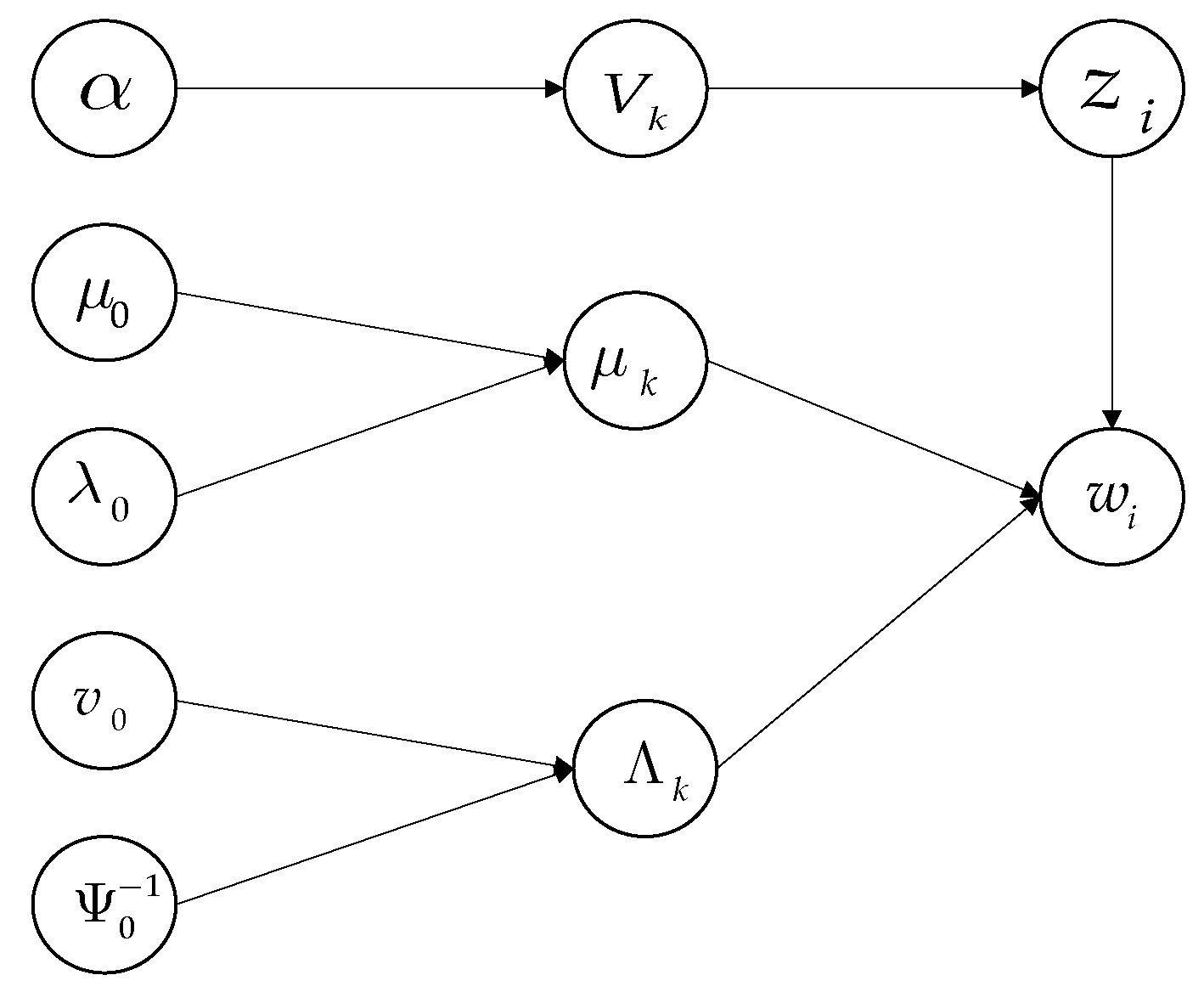
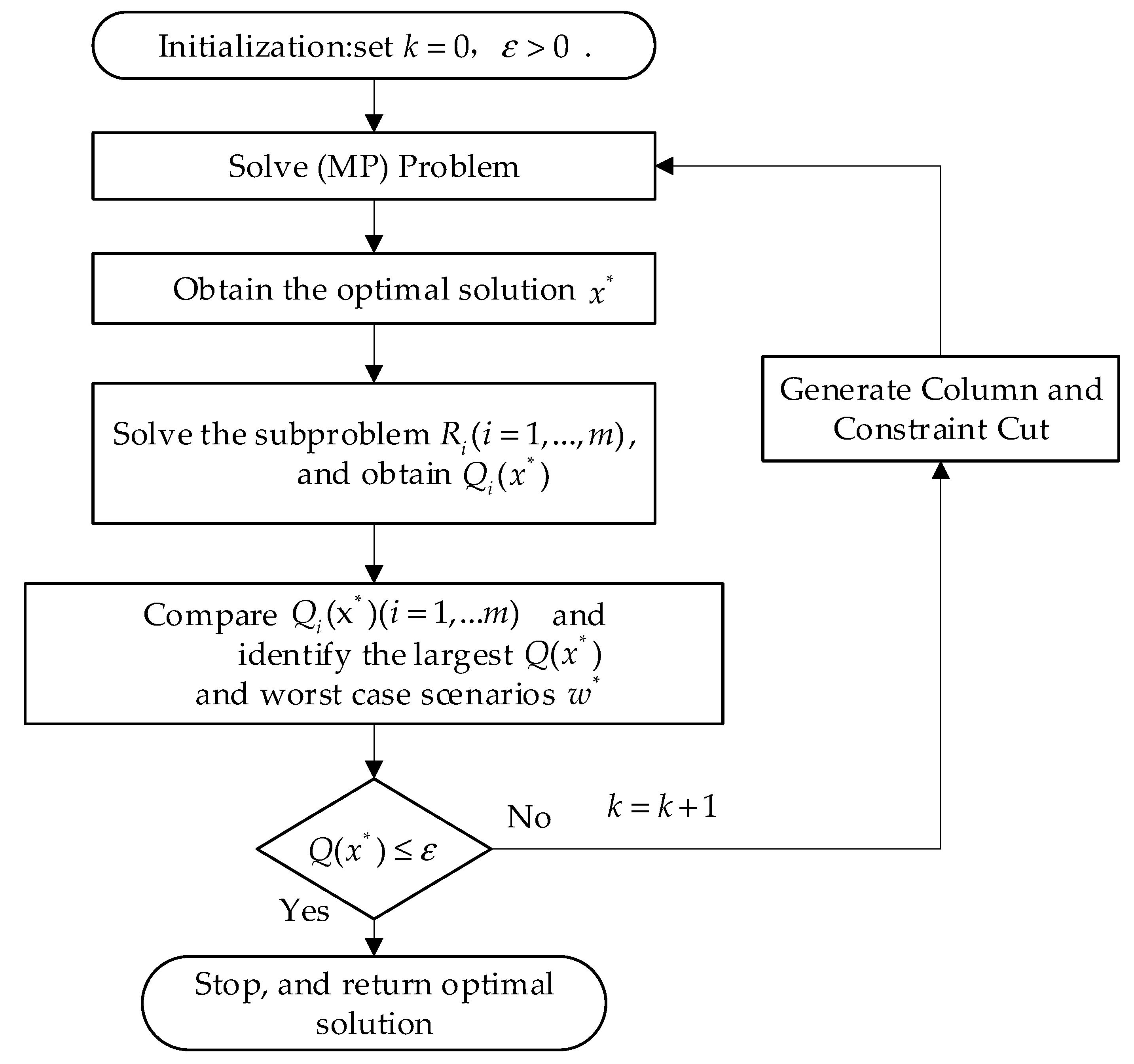
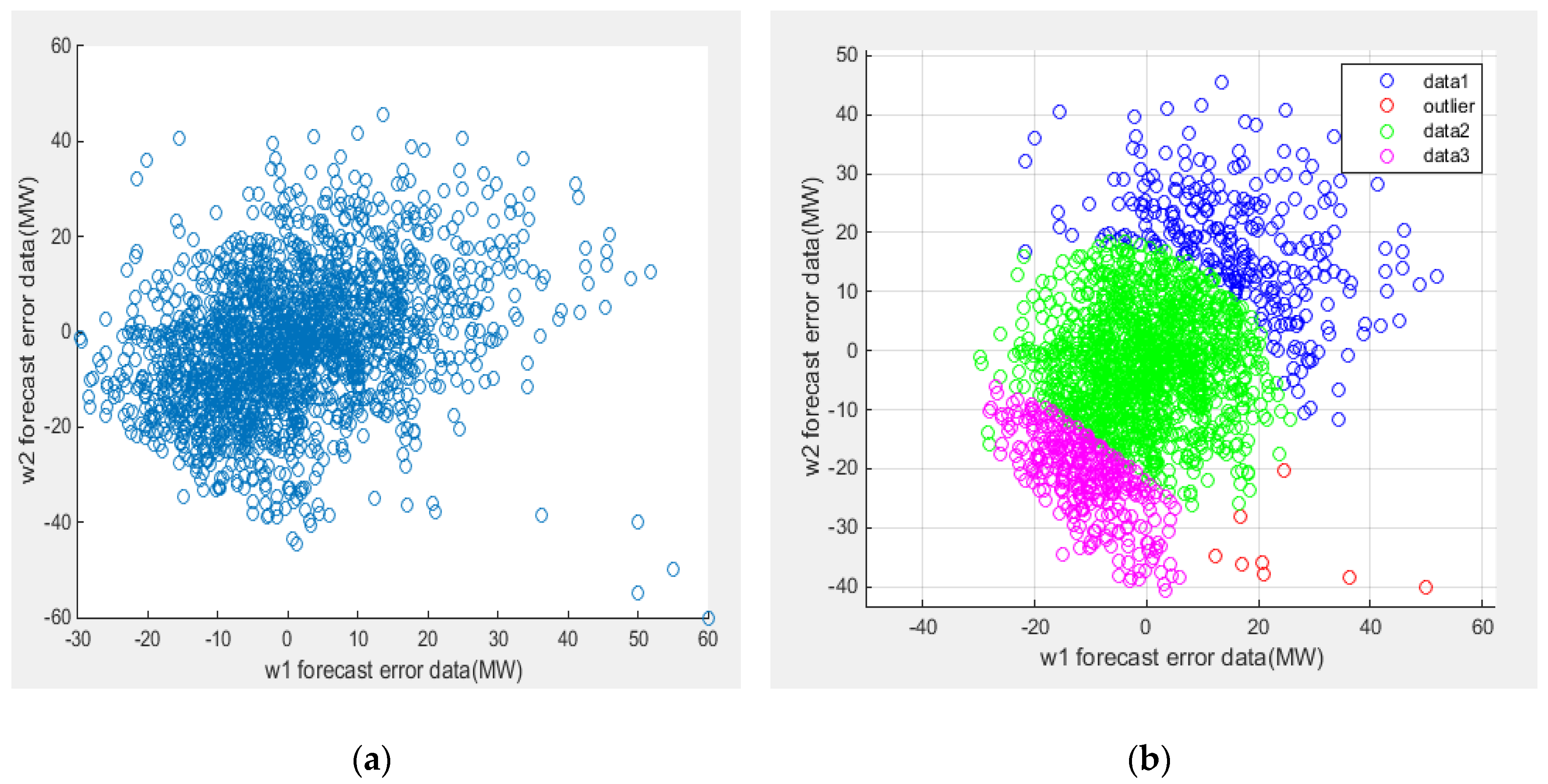
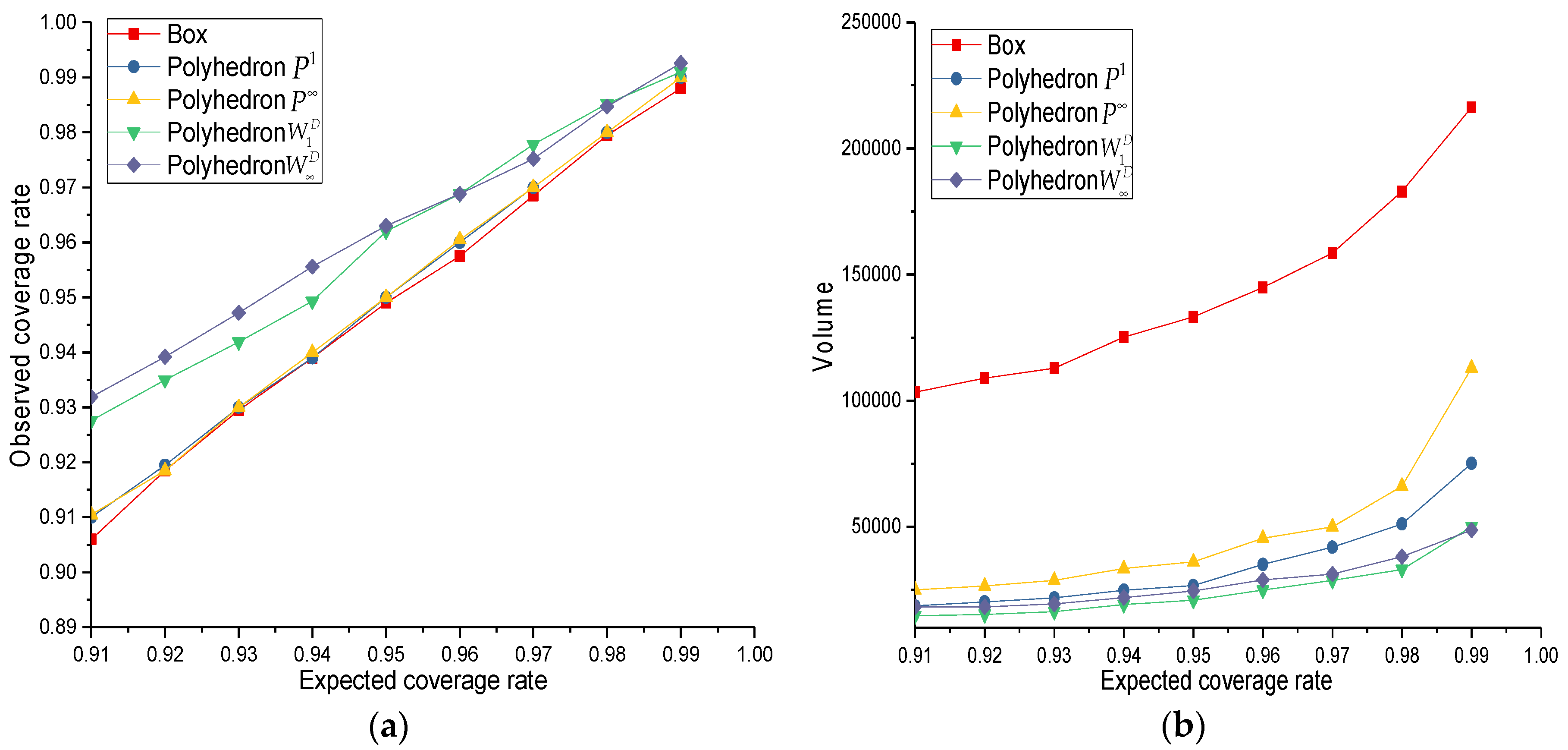
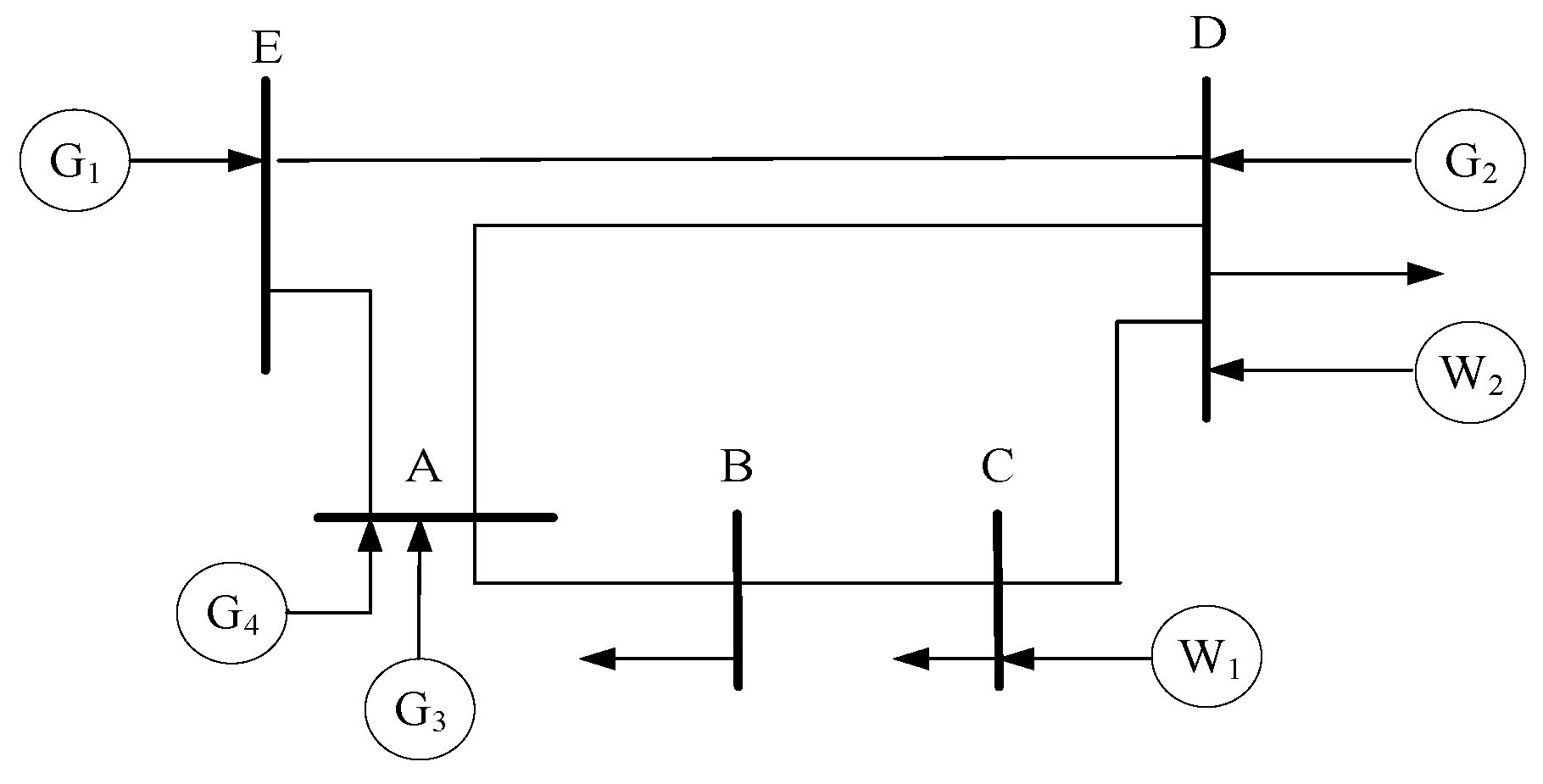
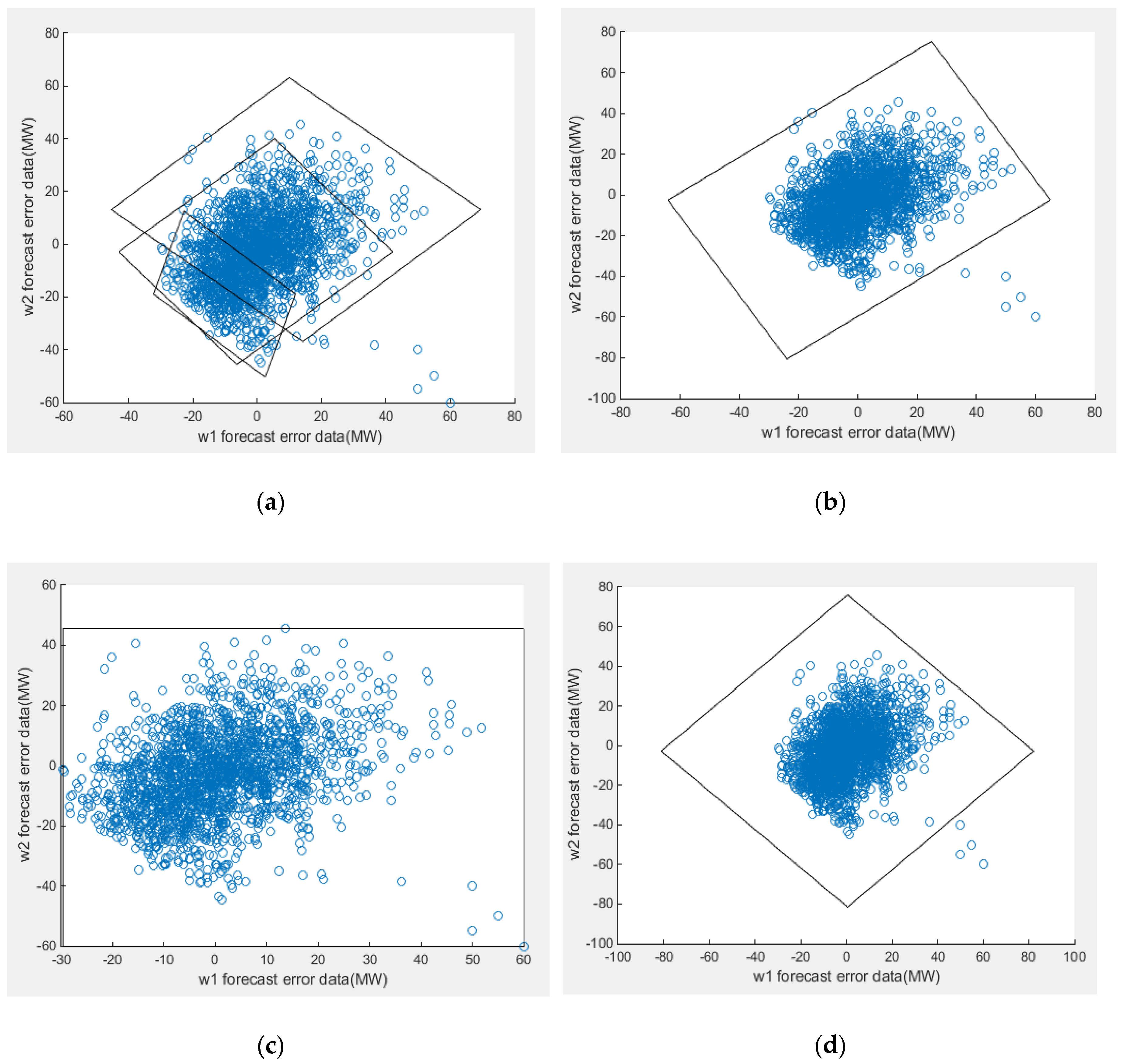
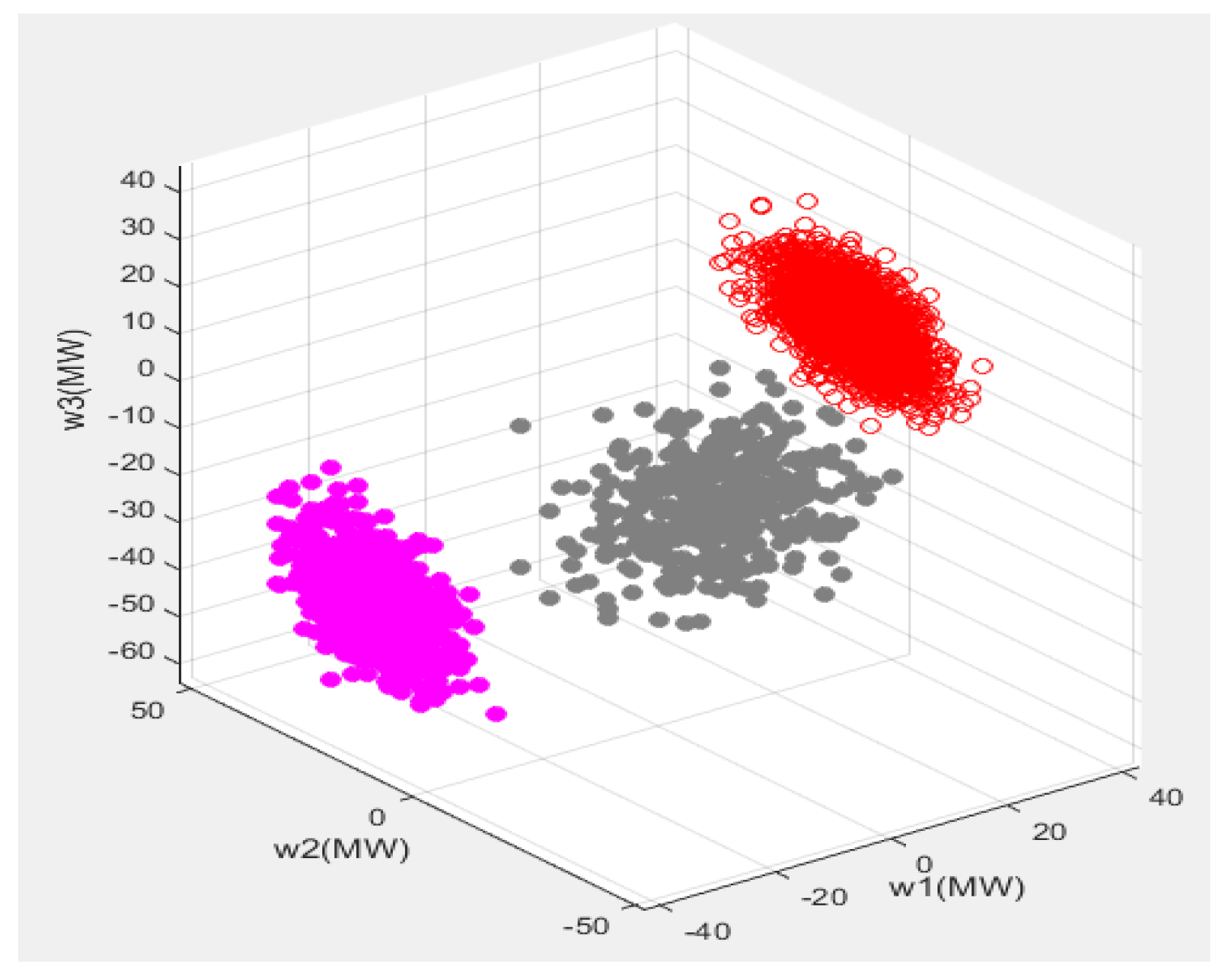
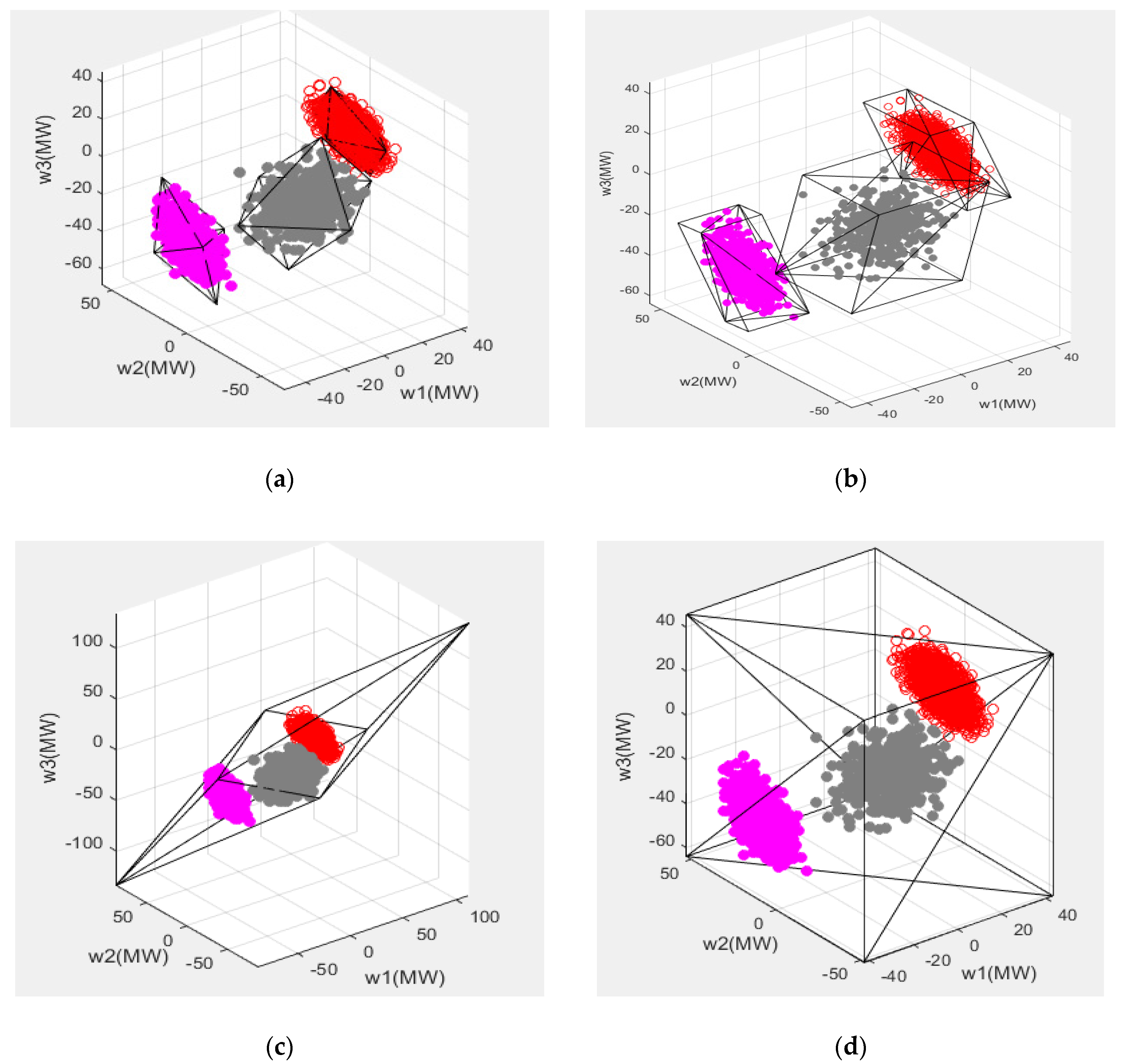
| Robust Uncertainty Set | Box Uncertainty Set | Polyhedral Uncertainty Set | Polyhedral Uncertainty Set | Data Driven Polyhedral Uncertainty Set | Data Driven Polyhedral Uncertainty Set |
|---|---|---|---|---|---|
| Expected coverage rate | 0.999 | 0.999 | 0.999 | 0.999 | 0.999 |
| Calibration | −0.0005 | 0 | 0 | 0.0005 | 0.0005 |
| Volume | 753.34 | 719.41 | 741.76 | 630.49 | 681.25 |
| Unit No | MW | (USD/MW) | (USD/MW) | (USD/MW) | Reserve Price (USD/MW) | Ramp MW/h |
|---|---|---|---|---|---|---|
| 1 | [180 400] | 0.01059 | 8.3391 | 64.16 | 30 | 100 |
| 2 | [100 300] | 0.010875 | 12.8875 | 6.78 | 45 | 60 |
| 3 | [150 600] | 0.01057 | 10.76 | 32.96 | 54 | 150 |
| 4 | [120 500] | 0.008401 | 12.3299 | 28 | 40 | 120 |
| Uncertainty Set | Box Uncertainty Set | Polyhedral Uncertainty Set () | Gamma Uncertainty Set | Data Driven Robust Uncertainty Set () | Data Driven Robust Uncertainty Set () |
|---|---|---|---|---|---|
| Data coverage rate | 99.9% | 99.9% | 99.9% | 99.9% | 99.9% |
| Operation cost ($) | 20,413 | 20,757 | 19,570 | 18,446 | 19,207 |
| Up reserve (MW) | 89.70 | 104.56 | 83.74 | 51.87 | 65.42 |
| Down reserve (MW) | 105.60 | 100.27 | 79.50 | 82.68 | 93.60 |
| Reserve cost ($) | 5915 | 6193 | 4996 | 4036.6 | 4770.3 |
| Computation time (s) | 15 | 18.36 | 30.18 | 40.61 | 34.50 |
| MDRO | PRO () | BRO | DDRO () | DDRO () | |
|---|---|---|---|---|---|
| Operation cost (USD) | 6,181,277 | 6,181,945 | 6,181,927 | 6,180,928 | 6,181,082 |
| Difference value (USD) | 668 | 0 | 18 | 1017 | 863 |
| Up reserve (MW) | 110.0 | 133.69 | 158.32 | 104.91 | 120.08 |
| Down reserve (MW) | 110.07 | 160.07 | 141.85 | 54.93 | 76.25 |
| Reserve cost (USD) | 1526.1 | 2194.2 | 2176.2 | 1177.3 | 1331.1 |
| Computation time (s) | 350 | 27 | 53 | 110.32 | 120.12 |
© 2020 by the authors. Licensee MDPI, Basel, Switzerland. This article is an open access article distributed under the terms and conditions of the Creative Commons Attribution (CC BY) license (http://creativecommons.org/licenses/by/4.0/).
Share and Cite
Dai, L.; You, D.; Yin, X. Data Driven Robust Energy and Reserve Dispatch Based on a Nonparametric Dirichlet Process Gaussian Mixture Model. Energies 2020, 13, 4642. https://doi.org/10.3390/en13184642
Dai L, You D, Yin X. Data Driven Robust Energy and Reserve Dispatch Based on a Nonparametric Dirichlet Process Gaussian Mixture Model. Energies. 2020; 13(18):4642. https://doi.org/10.3390/en13184642
Chicago/Turabian StyleDai, Li, Dahai You, and Xianggen Yin. 2020. "Data Driven Robust Energy and Reserve Dispatch Based on a Nonparametric Dirichlet Process Gaussian Mixture Model" Energies 13, no. 18: 4642. https://doi.org/10.3390/en13184642
APA StyleDai, L., You, D., & Yin, X. (2020). Data Driven Robust Energy and Reserve Dispatch Based on a Nonparametric Dirichlet Process Gaussian Mixture Model. Energies, 13(18), 4642. https://doi.org/10.3390/en13184642





